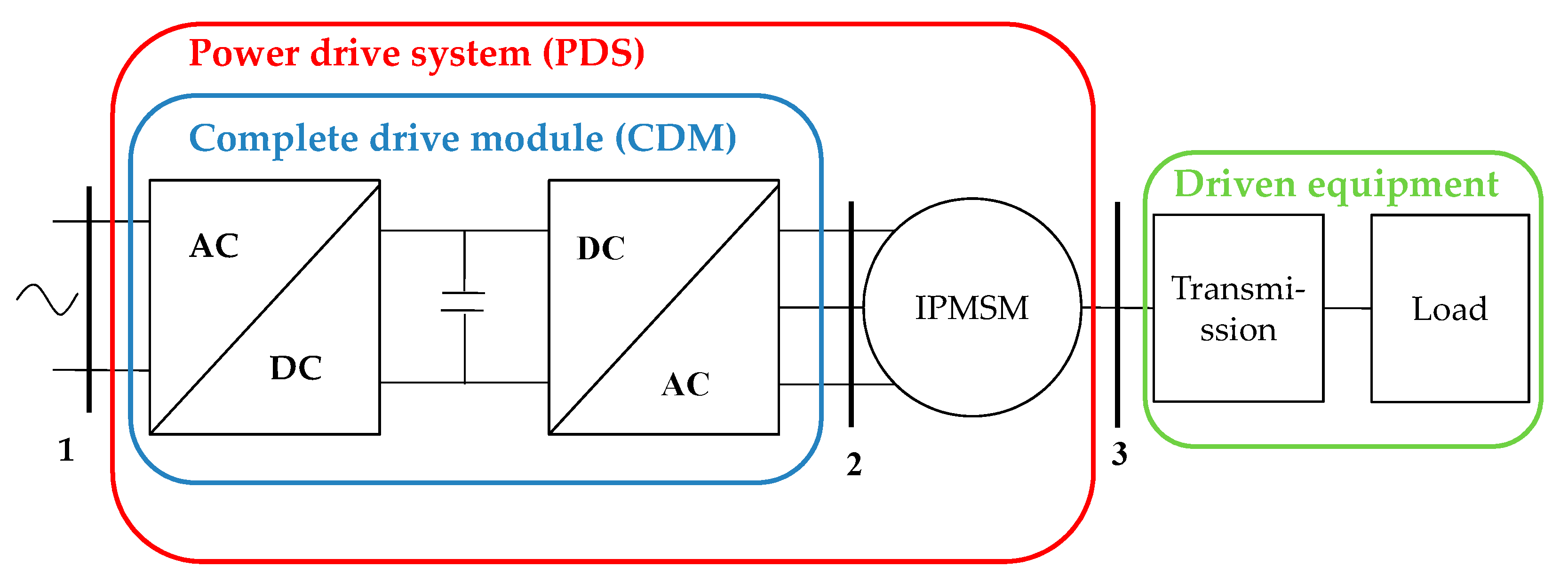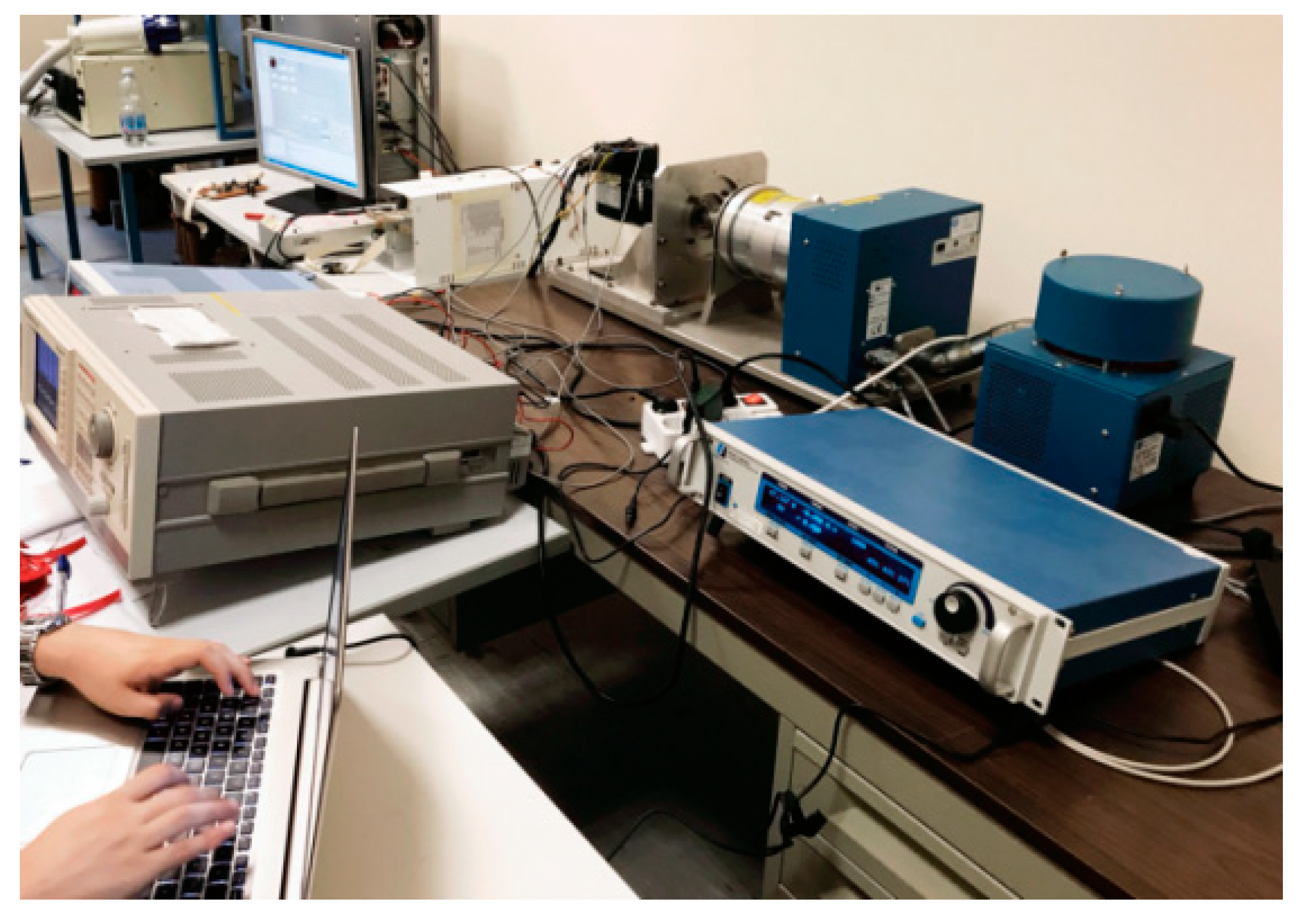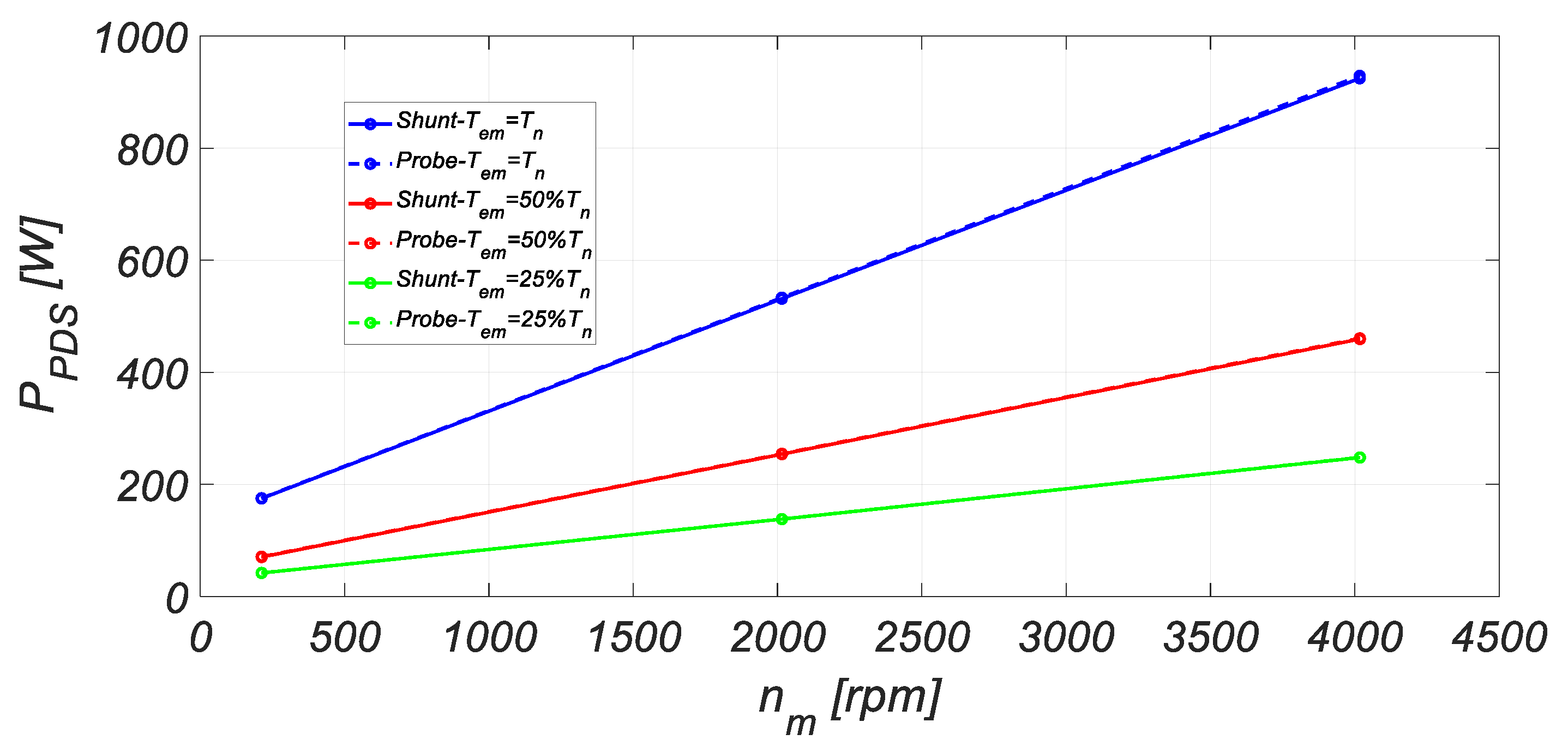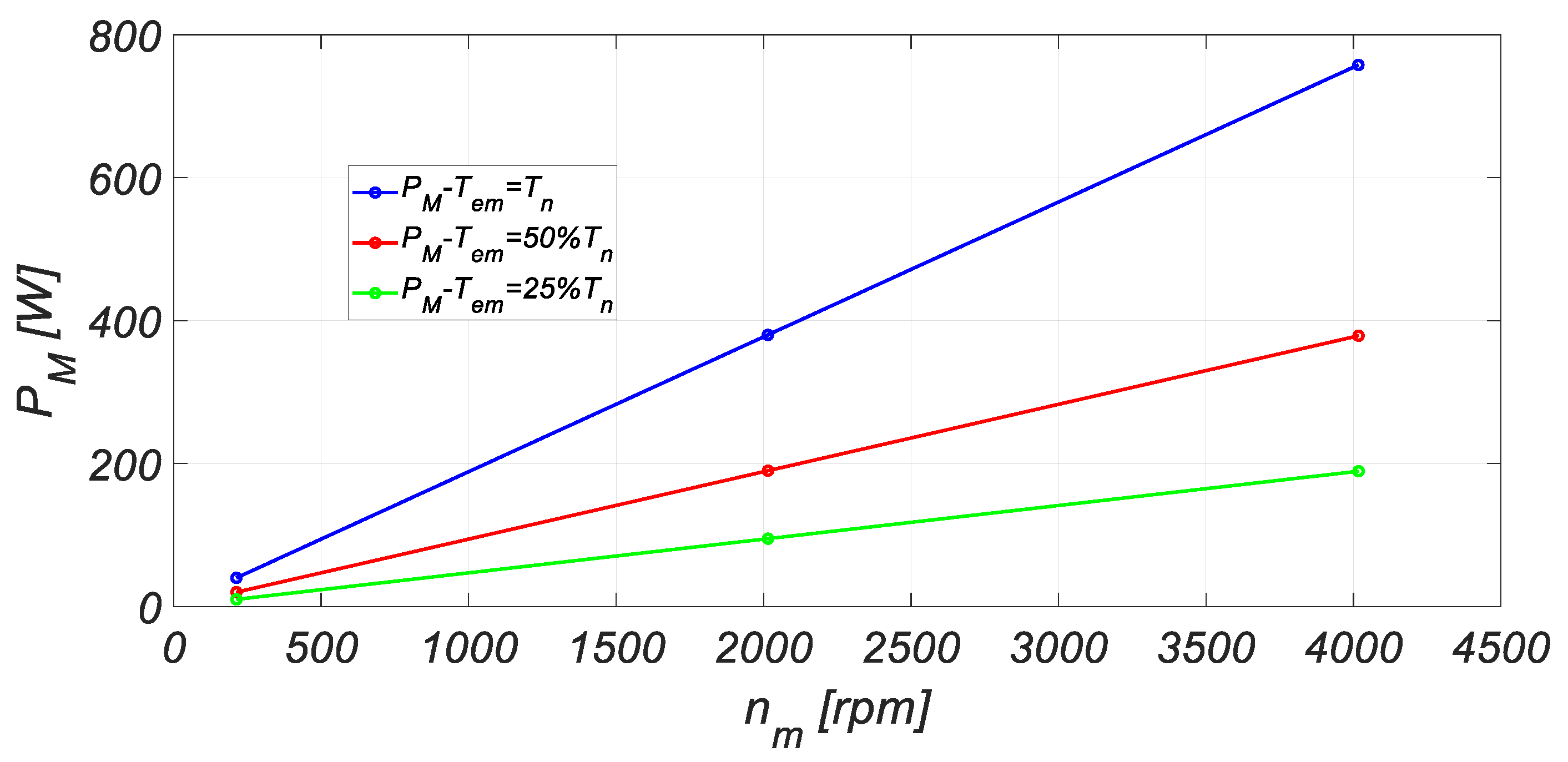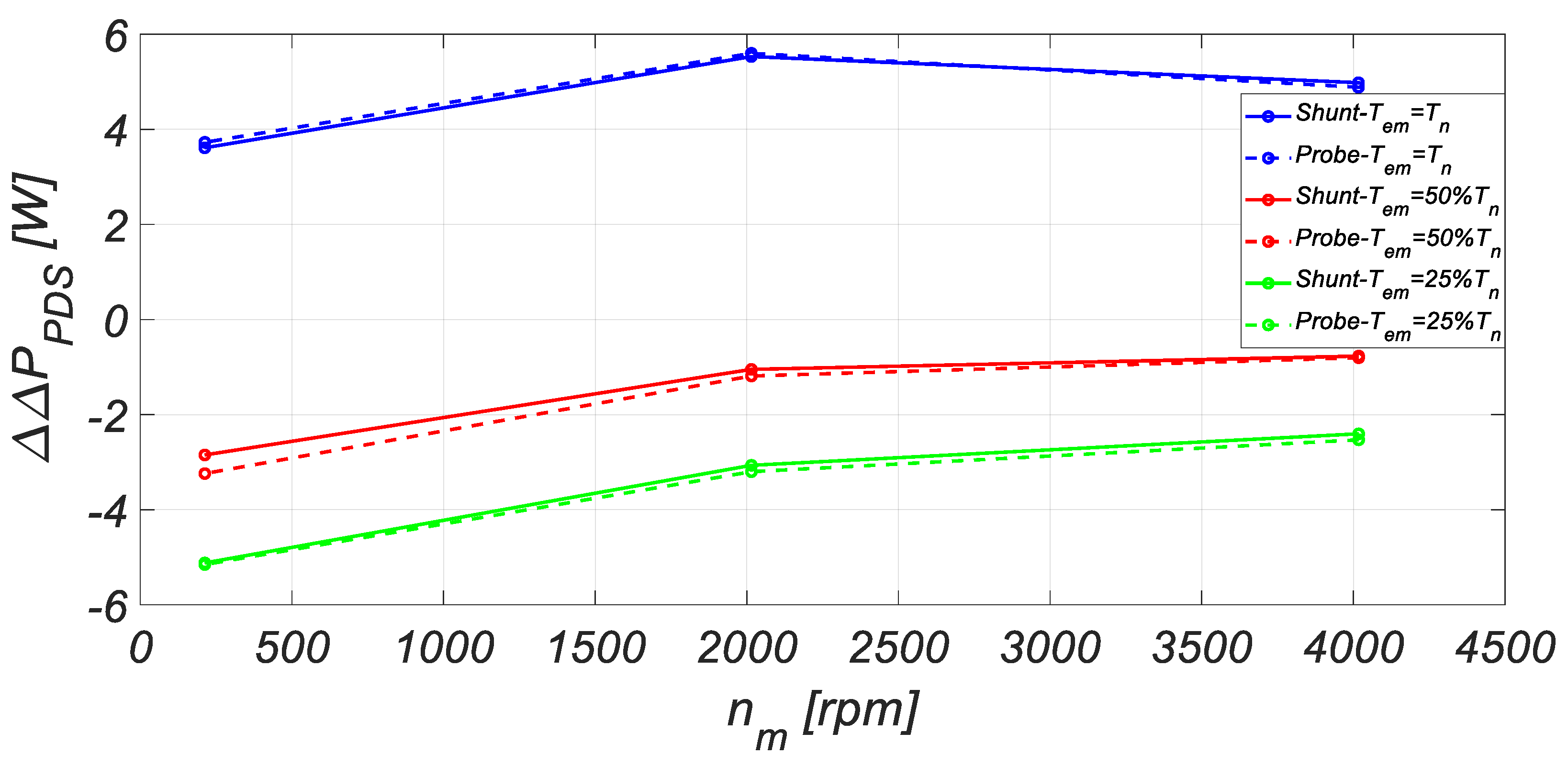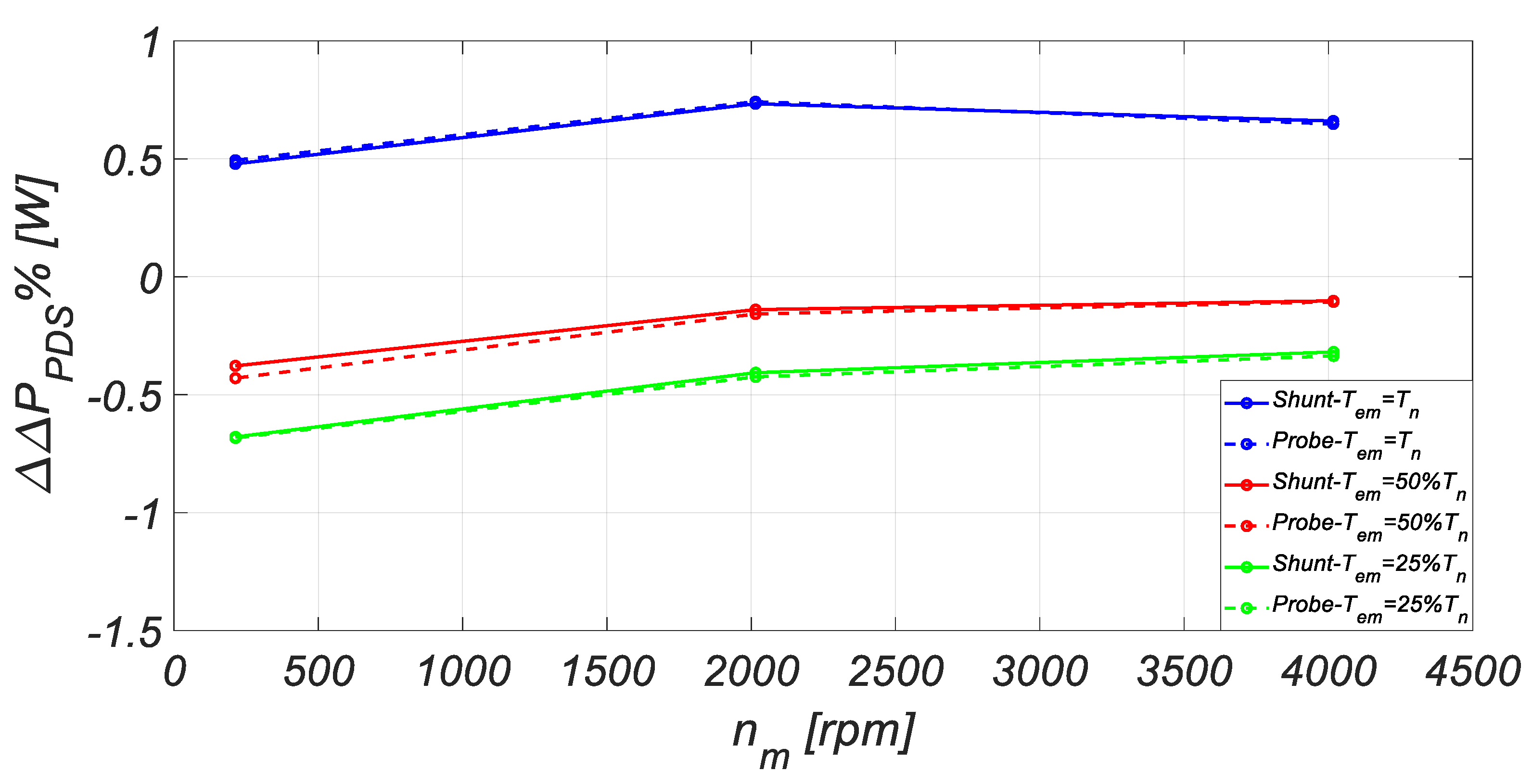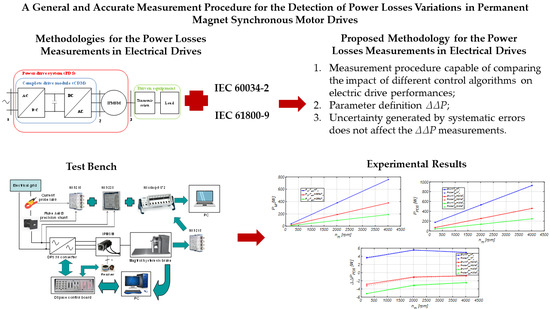5.1. Data Acquisition Procedure
Based on the statements reported in the previous Sections and since the rated power of the IPMSM under test is lower than 1 kW, the direct method has been adopted in order to evaluate the efficiency of the PDS described in
Section 3.
Figure 4 shows a photograph of the test bench during a set of measurements of the PDS power losses.
The speed and torque transducers employed in the electrical drive under test satisfy the measurement requirements of the standard IEC 60034-2 [
20].
The acquisition of both the electrical and mechanical quantities is carried out through the transducers (see
Section 4) in a Labview environment. This acquisition is carried out with the Express Virtual Instrument (VI) DAQ Assistants, characterized by:
Sampling frequency, namely fs;
Single acquisition time or measurement time, namely TM.
The number of samples in one acquisition is given by:
During a single acquisition time, the instantaneous values of electrical and mechanical quantities are acquired so that the instantaneous values of electrical power
pPDS(
t) and mechanical power
pM(
t) are computed by means of the following relationships:
where
vPDS(
t) is the instantaneous value of the PDS input voltage,
iPDS(
t) is the instantaneous value of the PDS input current,
Tem(
t) is the instantaneous value of the electromagnetic torque and
ωm(
t) is the instantaneous value of the mechanical speed. By means of the Labview VI library (e.g., VI BASIC DC RMS), the overall rms values of voltage and current quantities, as well as the mean value of instantaneous electric power and the mean value of mechanical quantities are computed with respect to time
TM. More specifically, the computation of the mean value of the instantaneous electric power allows considering the contribution, in terms of active power, of each product between isofrequential harmonic components of both voltage and current.
Consequently, in a period equal to TM, it is possible to obtain one sample for each electrical and mechanical quantity, allowing the possibility of repeating this process and performing a very wide range of time window, without affecting the PC memory with a large number of samples.
Besides, the adoption of several measurement samples allows the evaluation of the average value and the measurement deviation for each quantity. The single measurement, which is characterized by
TM and
fs, is, then, implemented in a single iteration of a
for loop. The number of iterations
N corresponds to the number of desired measurement samples. The total observation time or the total acquisition time
Tw is equal to:
At the output of each loop iteration, the measurement sample is stored in an external array. At the end of the cycle, an array is obtained for each quantity of interest, consisting of scalar elements. The measurement arrays obtained are summarized in
Table 7.
The efficiency of the PDS is computed within the for loop by adopting the values of the active power evaluated in the input and mechanical sections and adopting the direct method. Therefore, the following efficiency arrays are defined and measured:
In order to evaluate the average value, the VI standard Deviation and Variance are employed in the software. The sampling frequency values
fs and the acquisition time
TM adopted for the two DAQ Assistants are equal to 50 kHz and 60 s, respectively, satisfactory for the requirements of the PDS input section and the prescription of the standards [
21,
22].
In order to obtain a synchronous sampling between the measurement sections, the same measurement time was chosen.
Finally, the overall observation time Tw has been set equal to 40 min, which allows the repeatability of the measurements.
5.2. Results and Discussions
As suggested by the IEC 61800-9-2 standard, the IPMSM working points taken into consideration for the efficiency measurement, corresponding to different conditions of load and speed, are reported in
Table 8.
By defining
Tn and
ωn as the rated IPMSM torque and speed values and according to
Table 8, an additional point (no.7), which is not suggested by the standard, is included within the sets of measurement.
Concerning the ωm = 0, the standard defines this speed as a sufficiently low-speed corresponding to a supply frequency of the motor lower than 12 Hz. In this investigation, the low speed is equal to 200 rpm.
Moreover, in order to simulate the behavior of two different control algorithms, for each working point, the measurements are taken at two different values of the direct axis current Id, equal to −1 A and 0 A, which have been set by means of the FOC strategy.
As already mentioned, 40 measurement samples were acquired for each of the quantities of interest previously defined. Each measurement sample presents a duration of 60 s and the overall observation window is equal to 40 min. In such a way, the related arrays of voltage and currents, in terms of rms and mean values of torque and speed, are created. For instance, the mean values for the first working point are reported in
Table 9.
Furthermore, with regard to the repeatability of the measurement and the evaluation of the uncertainty, it is needed to evaluate the standard deviation for each quantity of interest. For instance, the average values of the standard deviation for the first working point are reported in
Table 10.
As reference examples,
Figure 5 and
Figure 6 show the average values of the PDS input active power and the output mechanical power as a function of mechanical speed
nm [rpm] for
Id = −1 A.
From the acquired values of active power, it is possible to determine both the power losses and the efficiency of the entire PDS under test. For instance,
Table 11 reports the efficiency detected for each working point at
Id = −1A.
It can be noticed that the highest efficiency values are detected for the load torque condition Tem = 50% Tn. Moreover, for the speed condition ωm = 0, the PDS efficiency obtained at Tem = 25% Tn is higher than the one obtained at Tem = 50% Tn. However, for speed conditions ωm ≥ 50% ωn, the PDS efficiency obtained at Tem = 25% Tn is lower than the one obtained at Tem = 50% Tn. In any case, for all the proposed working points, the PDS efficiency values measured with the shunt resistor (continuous lines) are higher than those measured with the Fluke current probe (dot lines). These results highlight a not negligible difference between the efficiencies measured with the two measurement system. Similar behavior has been detected for Id = 0 A.
The PDS efficiency uncertainty is affected by errors on power measurement both in the input single-phase section than in the output mechanical section. Regarding the PDS input single-phase section, the two current transducers adopted in this work present different accuracy. In particular, the uncertainty regarding the active power measurement in the single-phase sector with the shunt resistance has been already computed in [
33], which is equal to 0.05%, corresponding to an extended uncertainty equal to 0.13% with a 99% of confidence level. With regards to the power measurement with the probe, the uncertainty is relatively high, due to an error equal to 2% ± 0.06 A and its angle error is not known. An appropriate angle error value is obtained by comparing the average specifications of the current probe transducer with those of the same precision class, reaching, therefore, the value of 0.03 rad. The expanded uncertainty on the measurement of PDS input single-phase power by Fluke current probe is equal to 9.3% (99% confidence interval).
The mechanical power measurement is mainly affected by the error introduced by the dynamometer, while the one introduced by the NI 9215 is negligible. From the data provided by the dynamometer datasheet, the expanded uncertainty on the measurement of mechanical power is equal to 0.17% with a confidence interval of 99%.
The mechanical power can also be measured by directly reading on the dynamometer interface. In this case, the related error is obtained from the datasheet of the used brake, equal to 0.01% for the speed and to 0.5% for the torque. The expanded uncertainty on the measurement of mechanical power with this second method is equal to 0.74% with a confidence interval of 99%.
Finally, the uncertainty concerning the efficiency measurement with the first system (shunt resistance and acquisition of torque and speed) is equal to 0.21% with a confidence interval of 99%, whereas the second system (Fluke current probe and acquisition of torque and speed) is characterized by an uncertainty equal to 9.4% with a confidence interval of 99%. The uncertainties considerations are valid for each case of study (Id = −1 A, Id = 0 A).
The PDS efficiency measurement performed with the first measurement system complies with the IEC61800-9 uncertainty prescriptions and, therefore, can be used for the PDS energy classification. On the contrary, the second measurement system is not suitable for the PDS energy classification. This fact underlines the need for high accuracy and high-cost instrumentation for the efficiency measurement of electric drives.
